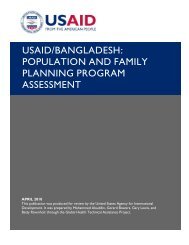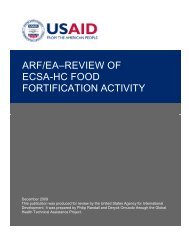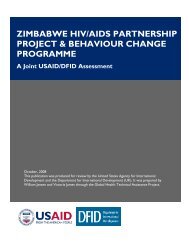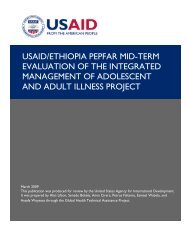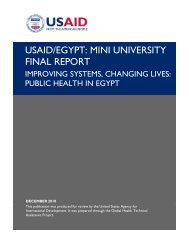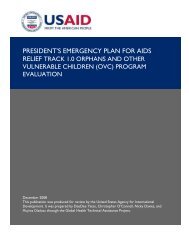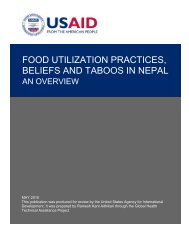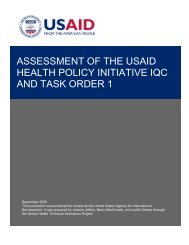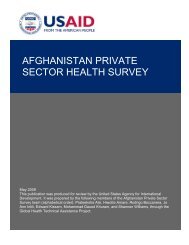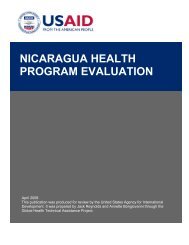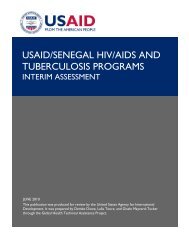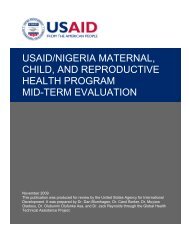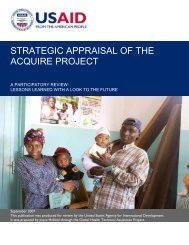Evaluation of the Tuberculosis Control Assistance Program (TB CAP)
Evaluation of the Tuberculosis Control Assistance Program (TB CAP)
Evaluation of the Tuberculosis Control Assistance Program (TB CAP)
You also want an ePaper? Increase the reach of your titles
YUMPU automatically turns print PDFs into web optimized ePapers that Google loves.
The PMU should adopt a definition <strong>of</strong> accrual that allows for estimated expenditures to be reportedun<strong>of</strong>ficially to allow for better estimating <strong>of</strong> progress and future financial needs.Financial ReportingUSAID reports that day-to-day PMU forecasts <strong>of</strong> funding requirements in some cases seem unreliable; forexample, costly activities were known to have begun but forecasts for <strong>the</strong> costs are unrealistically low. On<strong>the</strong> o<strong>the</strong>r hand, independent auditors have confirmed that <strong>TB</strong> <strong>CAP</strong> is presenting its annual financialstatements to USAID fairly, and USAID perceives annual PMU financial reporting as being generallytimely. The PMU has been informeding USAID <strong>of</strong> possible delays in advance, reasonably explained why<strong>the</strong> delay might occur, and receiving USAID approval to deliver later than expected if necessary.It is less clear if <strong>the</strong> detailed financial information presented in <strong>TB</strong> <strong>CAP</strong> annual reports is reliableassessing progress. Figures <strong>of</strong>ten change from year to year without explanation. The number andfrequency <strong>of</strong> changes in <strong>TB</strong> <strong>CAP</strong> annual reports suggests that <strong>the</strong> figures are not definite at <strong>the</strong> time <strong>of</strong>reporting and <strong>the</strong>refore may not be accurate. Fur<strong>the</strong>rmore, <strong>the</strong>se are <strong>of</strong>ten figures that would be expectednot to change (such as a country budget approved two years ago), which raises questions about <strong>the</strong>soundness <strong>of</strong> PMU financial management practices. Among many examples, more than half <strong>the</strong> approvedAPA2 budgets for 15 countries listed in <strong>the</strong> year 2 report changed in <strong>the</strong> year 3 report withoutexplanation, and <strong>the</strong> APA1 Approved Management Budget changed in each annual progress report (from$1.14 million to $1.05 million to $1.13 million).Since <strong>the</strong> <strong>TB</strong> <strong>CAP</strong> project seems to take longer than anticipated to disburse approved budgets, annualspending is an important indicator for monitoring progress. Actual spending for <strong>TB</strong> <strong>CAP</strong> projects in agiven year, however, is not possible to determine. For countries, <strong>TB</strong> <strong>CAP</strong> progress reports calculatespending by comparing all country budgets (including budgets from previous years) with all countryexpenditures (including expenditures from previous years). As a result, <strong>the</strong> spending reported in eachannual report reflects not spending against budget for that year but <strong>the</strong> cumulative average. Notsurprisingly, <strong>the</strong>n, <strong>the</strong> average appears to be improving every year (54% in APA1, 66% in APA2, and73% in APA3) as more and more budgets and completed expenditures are back-loaded into <strong>the</strong> formula.Although not ideal, a truer measure <strong>of</strong> <strong>the</strong> annual change in spending is to look only at countries in <strong>the</strong>irfirst year, when <strong>the</strong>y have no previous budgets or expenditures to weight <strong>the</strong> average. If this is done,spending for new projects has not improved: 54% in APA1 (10 countries), 54% in APA2 (9 countries),and 8.2% in APA3 (2 countries). For core projects in <strong>the</strong>ir first year, <strong>the</strong> trend is in fact regressing: 71.5%in APA1, 66% in APA2 and 58% in APA3. This effect is no doubt heavily influenced by <strong>the</strong> start dates <strong>of</strong>projects (many <strong>of</strong> which start late in a reporting year) and <strong>the</strong> trend in core projects <strong>of</strong> programmingmultiyear efforts within a forced single-year framework.E. MONITORING AND EVALUATIONAn independent evaluation found that M&E <strong>of</strong> activities was an area <strong>of</strong> weakness in <strong>the</strong> predecessorproject, and with <strong>the</strong> addition <strong>of</strong> an M&E specialist in <strong>TB</strong> <strong>CAP</strong>, this area is perceived as having vastlyimproved. In particular, <strong>the</strong> reporting on technical progress in countries and <strong>the</strong> impact <strong>of</strong> <strong>TB</strong> <strong>CAP</strong>projects appears to be well accounted for. The information (qualitative and, to a lesser extent,quantitative) generated by <strong>the</strong> PMU is valuable for communicating <strong>the</strong> value that <strong>TB</strong> <strong>CAP</strong> has forcountries and <strong>the</strong> international community. This reporting is considered to be timely and <strong>of</strong> high quality.M&E <strong>of</strong> project finances is also much better, although <strong>the</strong> PMU and partners must continue to improve<strong>the</strong> speed and reliability <strong>of</strong> financial reporting and refine financial indicators to ensure <strong>the</strong>y require only aminimum burden to generate.In o<strong>the</strong>r respects, however, little has been done to address recommendations related to M&E from thatearlier evaluation, particularly monitoring <strong>the</strong> responsibilities <strong>of</strong> <strong>the</strong> partners and evaluating project12 EVALUATION OF THE TUBERCULOSIS CONTROL ASSISTANCE PROGRAM (<strong>TB</strong> <strong>CAP</strong>)



